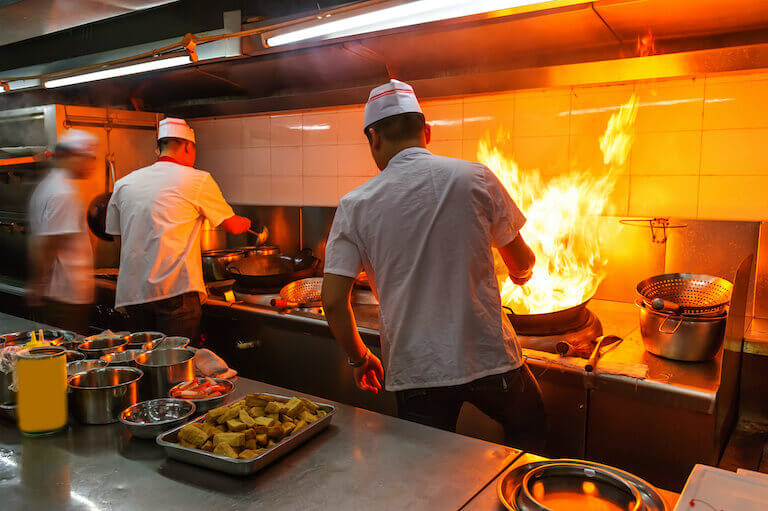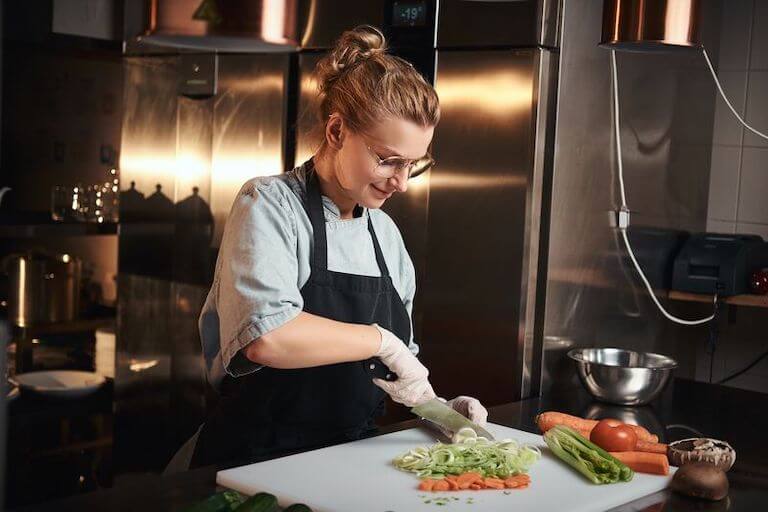Walk into any professional kitchen at the height of a busy shift, and you’re bound to hear the staff barking out words and phrases that only they can understand.
Chef jargon might go something like this: “We’ve had 100 covers already, and I’m really in the weeds over here, so I need everyone to step up and make sure these dinners aren’t dying on the pass.”
Like any workplace, the kitchen has a language all its own, from official terminology to slang and shorthand that cuts through verbal clutter and keeps things humming along. Here’s a handy guide to some common jargon you’re likely to hear if you find yourself behind the scenes at a busy restaurant.
Standard Cooking Terms vs. Jargon: Why Use Kitchen Slang?
They can overlap, but there’s a difference between the more formal culinary vocabulary you are likely to pick up when attending a culinary arts program and the Saturday night chatter when the restaurant is packed and the kitchen is going full tilt.
For example, the restaurant might serve a London Broil, or a boneless cut of steak that is marinated and then broiled or grilled, but the kitchen might shout, “Cow, medium rare!” It’s important that everyone on staff understand the terms being used; in this example, everyone in the kitchen would understand what “cow” means and wouldn’t confuse a steak with a hamburger.
Slang saves time—it’s more efficient to shout “Behind!” instead of, “Watch out, I’m about to walk behind you and I’m carrying a tray filled with blazing hot soup.” And slang is often unique and not likely to be confused with other words.
You’ll find jargon for locations in the kitchen, equipment, prep and cooking, and more.
What Does “All Day” Mean in a Kitchen?
When it gets busy and multiple orders are coming in simultaneously, it’s helpful for a chef to cut to the chase and clarify how many of a particular dish they need in total. They may ask for an “all-day count” on that dish, and/or they may shout out the total so that all chefs and cooks understand what to prepare and then deliver it on time.
An example might be: “You’ve got eight salmon all day, chef, and a chicken parm on the fly.”
Translation: Eight orders for salmon have come in on different tickets, so the kitchen knows how many to make in total. They also have to make a chicken parmesan quickly, whether because it was forgotten or because it was dropped.

Kitchen slang makes communication more efficient in a crowded workspace.
Jargon Can Be Rooted in Kitchen Hierarchy
Kitchen jargon makes more sense if you first understand the brigade de cuisine system, created by Auguste Escoffier himself.
In this system, each member of the kitchen staff specializes in specific tasks and has specific roles. Much like the military ethos, there’s a kitchen hierarchy that is adhered to with precision, a chain of command, and a procedure for the flow of information.
This chain of command and flow includes an executive chef who’s in charge of the kitchen, a sous chef who’s second in command, and a number of other positions, from pastry chefs to line cooks and prep cooks.
Within that chain, information flows up and down, with a lot of call-and-response style language that makes communication clear and efficient. When you understand how meals are made and served, plus who is in charge and which direction information flows, kitchen jargon can make more sense.
Lingo for Equipment and Spaces
Restaurant lingo includes terms for tools and equipment as well as physical spaces in the front of the house and the back of the house. Here are some of the most common:
Front of House (Where Customers Go)
- Cover: Number of customers served, similar to a head count, i.e., “We did 150 covers tonight.”
- Floor: Dining area of a restaurant; where customers sit
- Top: Table, preceded by a number indicating how many people can be seated, i.e. 4-top or 6-top
Back of House (Where Food Is Made)
- Board or Rail: The place where order tickets are hung
- Dupe or Chit: Ticket or order
- Line: Area of the kitchen where people are cooking
- Low boy: Fridge below the counter
- Pass: Area for orders that are ready to be served
- Walk-in and Deep: The former refers to the refrigerator where most dairy and produce items are stored. The latter refers to the deep freezer, where a lot of the meat and poultry is kept on ice.

Preparation, like mise en place, and communication are each essential in a kitchen.
Kitchen Communication Shorthand
Kitchen communication is its own language with a fast, precise cadence, so expediency is key. Common words and phrases heard in the kitchen include:
- Behind/Corner: Alert others that you are about to walk behind them or are coming around a corner
- Fire: Start cooking a dish
- Hands: A call for help in carrying something, typically help carrying dishes to tables
- Heard/Heard That: A catch-all response in the kitchen to relay confirmation. Can be used when calling in an order or if someone’s moving through the kitchen space with a hot plate.
- Yes Chef/Oui, Chef: Response that lets the chef know their order has been heard and understood
Did You Know? The Bear Is a Case Study in Kitchen Slang
The popular Hulu comedy-drama show The Bear, about a chef who takes over the family sandwich shop, mixes kitchen slang effortlessly and hilariously into its dialogue.
In this clip, you can see scenes that showcase back-of-house jargon. You’ll hear the characters shouting “Hands!” and “All Day,” see an example of a call-and-response, and, in one somewhat cringeworthy scene, see why it’s vital to announce “Corner!”
On the Line: Prep and Cooking Terms
Unlike elegant terms for French cuisine or the specialty language you might use in the classroom and when discussing various flavor profiles, a shift in the kitchen becomes an exercise in staccato. People are focused on their tasks while also making sure they’ve coordinated with others. During any given shift you’re likely to hear the following:
- À La Minute: Made to order or made fresh
- All Day: Total number of a particular item or dish needed, to keep count of items on the kitchen rail or board. You might hear something like, “Yes, chef, there are five meatloaf platters all-day,” or even just “four fettuccine bowls all-day.”
- Flash it or Flash: Reheat something quickly, either because a customer sent it back or because it started to get cold on the pass
- Kill it: A well-done steak
- Mise: Short for “mise en place“
- On deck: The next dish coming up
- On the fly: When a dish is needed ASAP, expect to hear someone scream “on the fly” a handful of times. Usually this happens when a meal has been misplaced or was dropped by a waiter.
- OTS: On the side
- SOS: Sauce on the side
Other Commonly Used Kitchen Jargon
Each restaurant will develop its own code words, but some of the others you might hear regardless of location include these:
- 86: Remove an item from the menu
- Dying on the Pass: When a dish has been sitting on the pass for too long and the quality is potentially becoming compromised
- Expo: Short for expediter, a person who coordinates between the kitchen and the customer’s table, which means they must give the orders to chefs, and once the food is ready, organize it and deliver it to the respective table.
- In the weeds: Incredibly busy, probably running behind
- VIP: An especially important customer, often long-time customers, restaurant critics, notable personalities, and the like.
Explore Language and Technique at Escoffier
A professional kitchen can be a frenetic place where colorful personalities are working shoulder-to-shoulder. When you’ve got the culinary chops and the lingo figured out, it can make for an exciting and fulfilling career.
A formal culinary education can help. Escoffier offers degrees and diplomas in six different disciplines, from culinary arts and baking & pastry to hospitality & restaurant operations management.
Students can explore kitchen tools and techniques, hone communication skills, and gain on-the-job experience with an industry externship. To find out more, reach out to our team, who will be happy to give you more information about culinary school.
- 5 Effective Ways Chefs can Communicate With Wait Staff
- How to Become a Chef: The Essential Guide
- Executive Chef vs Head Chef: What is the Difference?
*Information may not reflect every student’s experience. Results and outcomes may be based on several factors, such as geographical region or previous experience.
This article was originally published on Dec. 22, 2015, and has since been updated.





